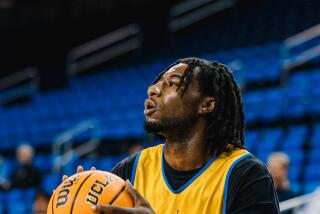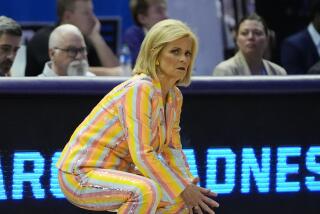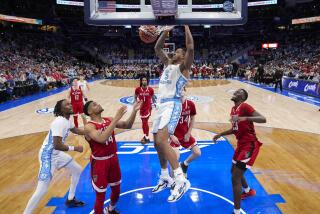NCAA MEN’S FINAL FOUR : A HOME TEAM : Road to Seattle Runs Through Streets of Chicago for Illinois
CHAMPAIGN, Ill. — Imagine the teams they might have had.
Isiah Thomas. Mark Aguirre. Terry Cummings. Jack Sikma. Maurice Cheeks. Glenn Rivers. Hersey Hawkins.
Sons of Illinois who decided to play someplace else.
Cazzie Russell. Dan Issel. Quinn Buckner. Rickey Green. Doug Collins. George Mikan.
Illinois boys who would not play ball with Illinois.
So many of them.
And now, the University of Illinois is making its first Final Four appearance in 37 years.
Thirty-seven years .
And you know what?
Every single player on the Illinois roster is from Illinois.
Stat-keepers from the National Collegiate Athletic Assn. are still trying to dig up statistics on this stuff--but, to their knowledge, no school has ever reached college basketball’s Final Four with every person on its roster a native son.
Until now.
Make way for the home boys.
Jimmy Collins has this big photograph in his office. It’s a picture of Ben Wilson.
In November, 1984, the Illini’s assistant coach and chief recruiter personally showed Ben Wilson around Champaign on his official campus visit. Wilson was one of the best high school players anybody had seen, a big, lissome kid from Simeon High School in Chicago who could, as they say, do it all.
On Nov. 20 of that year, one block from his high school, Ben Wilson and two classmates were walking along South Vincennes Avenue at noontime when they bumped into three guys going the other way. Wilson literally bumped into one of them. He apologized.
The guy pulled out a .22-caliber gun and put a bullet into him.
Nick Anderson, now a star forward for the Illini and also a former Simeon player, was in a grocery store at the time, maybe 100 yards from the shooting. He ran to Ben Wilson’s side, found him dangling over a fence.
Four days later, Anderson and other Simeon players, among them Ervin Small, now his teammate at Illinois, went to Oakwood cemetery to bury their friend. Jimmy Collins was there also, on his birthday.
They buried Ben Wilson in his blue-and-gold Simeon uniform, No. 25.
Nick Anderson wears 25 for Illinois, for this very reason. Ervin Small wears 24, because they couldn’t have two 25s.
It’s difficult to tell how much better these Illini might have been.
Until Collins came along--and, well, to be fair, Tony Yates before him--the state university kept getting the big freeze-out from cold, old Chicago. All-American preps would not even take a 2 1/2-hour trip downstate. Guys such as Thomas and Aguirre didn’t even visit. Talk about big ones that got away.
“When I first started on this job, it was obvious that there were bad feelings,” Collins said before leaving with the team for Seattle. “Several high school coaches up there obviously had some problem with us. What it stemmed from, I’m not sure.
“All I know is that we had to crack that Chicago market if we were ever going to be successful. And, by successful, I mean Final Four successful. We needed to convince the players and parents that Illinois was not a bad place.”
The head coach, Lou Henson, has put together several decent teams before this one. He has averaged 21 victories a year in his 14 seasons at Illinois. His squads came through the rugged, rigid Big Ten race in good enough shape to qualify for the NCAA tournament in 1986, 1987 and 1988, so this season’s success is hardly a quirk of fate.
Yet, just because those last three teams never got past the second round, and just because one of those teams was upset by the funny-sounding Austin Peay, it was suggested more than once that now that Henson finally had a first-rate recruiter, perhaps Illinois needed to go out and find a first-rate coach.
We are talking about a man here who even took New Mexico State to the NCAA tournament six times.
Can’t coach. Sure.
A low-key character from Okay, Okla., Henson is not offended.
“If we lose, we’ll go home and start for next year,” he said. “I’ve been in this business 34 years, so I’m not going to start worrying about what people say now. That’s for people in pool halls to talk about.”
Still, ol’ Lou is at least a little bit uptight.
He opened practice to outsiders Tuesday for only 20 minutes, then pulled the curtains shut for the rest of the week. It is a Georgetown-like quarantine meant for everybody, and Henson means everybody. No personal contact, no phone conversation, no anything.
“We can’t even talk to our parents,” Anderson said.
Are the Illini tight?
Uh, no.
The Illini are loose.
Before being sealed off from the world, a couple of players snapped off one final spontaneous rap song, as has become their habit during the tournament. They make these things up on the spur of the moment, strictly off the tops of their heads.
So, someone asked Ervin Small and Marcus Liberty, got another one before we go?
Small: “Gonna pass the ball . . .”
Liberty: “Oop.”
Small: “To Ervin Small . . . “
Liberty: “Oop.”
Small: “And that ain’t all . . . “
Liberty: “Oop.”
Small: “Illini gonna stand tall . . . “
Oh, well. Not exactly Run DMC. A pretty good indication, though, that Illinois is still managing to have some fun before the serious business of Saturday’s NCAA semifinal game against Big Ten rival Michigan.
The Illini already have beaten Michigan twice, so no wonder Henson is nervous.
This is no time for oops.
Eddie Johnson, Ken Norman and Derek Harper are about the only former Henson players who are doing much of anything in the NBA these days, despite all those excellent records Illinois racked up. Tells you something about the quality of superstar the school was attracting.
And Harper was from Florida.
Collins knew he had to hang onto the home boys. Aside from the fact that Chicago and its outlying area was a basketball hotbed, Illinois was not likely to be luring many blue-chip recruits to its campus on the plains from their homes near the oceans and beaches.
“I can remember when we’d have some guy here visiting on spring break,” Collins said, “and the whole student body would be gone, off to Ft. Lauderdale or someplace.”
Then again, winning changes things.
First, it calls the school’s program to national attention. Next, the big-time newspapers, magazines and TV cameras show up. Next, the native sons who decided to stay and play for State U. are calling up the old neighborhood kids or the All-Staters and saying: “Hey, this is OK, come on down.”
Ben Wilson liked Illinois, so Ervin Small got interested, which in turn got Nick Anderson interested. “We always wanted to play together,” said Small, who still believes that Wilson’s spirit is following him around. Small says he thinks about Ben “every time I bounce a ball.”
The first turning point recruiting-wise came a few years sooner, in the mid-1970s, when Coach Gene Bartow convinced scholastic All-American forward Audie Matthews of Chicago Heights to reject the likes of North Carolina and UCLA and go with Illinois. Although Matthews, considered at the time to be in the same league with people such as Moses Malone and Kenny Carr, did not evolve into NBA material, he did give the Illini four solid years.
That’s when other highly rated recruits, Eddie Johnson, for instance, started following suit, staying home.
Nowadays, Illinois is in the hunt for just about every All-State prospect. Liberty, for instance, was considered by many the No. 1 prep in the nation. The best schoolboy guard in Illinois at the moment, Jamie Brandon, a junior, already appears destined for the Illini.
And when another big one, Kenny Battle, did get away, to Northern Illinois, he changed his mind after two seasons and transferred. Henson, tongue in cheek, ordered Battle to apologize publicly after last week’s Midwest Regional title game against Syracuse.
“You should have been at Illinois all this time,” Henson told him.
Neither the head coach nor his recruiter, Collins, who happens to be from Syracuse, hails from the state himself, although Collins did play for a brief time with the Chicago Bulls. Both know, however, the quality of athlete that can be found there.
“And now, with the exposure we’re getting, kids can see the style of basketball we’re playing here,” Collins said. “Most of the young men I meet find this style of play exciting. And, they get excited thinking about playing in the Big Ten. So, I can see some California kid who prefers good basketball to beaches wanting to play for us.”
Hey, good recruiters never stop recruiting.
“Got any 7-footers you could send us?” Collins asked.
The Positionless Clones.
That has become the nickname of the Fighting Illini. Some people also call them the Flying Illini, because they play about two feet off the ground. But Positionless Clones--that’s a nickname for the ages, a name to remember, a name like no other. Right up there with Phi Slama Jama.
Illinois, see, has no centers, forwards or guards. They have five players, quintuplets, all right out of a cookie-cutter, all built alike, all 6-6 to 6-8 and slim-from-the-gym, all jumper-pumpers and backboard crashers. No longer is an Uwe Blab stomping around the lane like Herman Munster. These guys are short and sweet and fleet of feet.
They should be even more fleet than usual Saturday, since the week off has given minor injuries to players such as Battle, Lowell Hamilton and Kendall Gill more time to mend.
The timing also has been good to guard Larry Smith, whose mother, Bernice Caldwell of Alton, Ill., suffered a stroke last Thursday. Smith personally delivered to her the game ball from the Syracuse victory, and she was due to be released from the hospital just as her son was leaving for Seattle.
“One good thing,” Smith said. “If I was from California or someplace, it would have been a long way to go home to see her.”
Home-court advantage.
More to Read
Go beyond the scoreboard
Get the latest on L.A.'s teams in the daily Sports Report newsletter.
You may occasionally receive promotional content from the Los Angeles Times.










